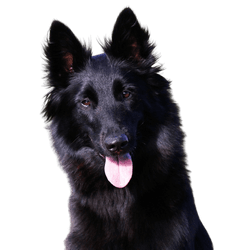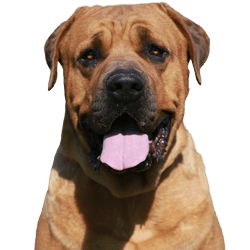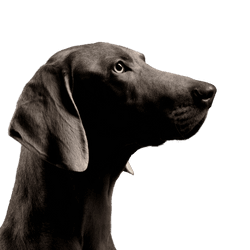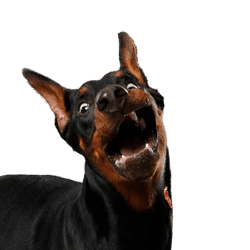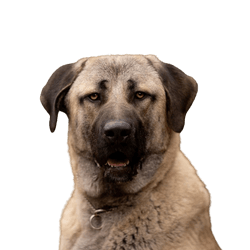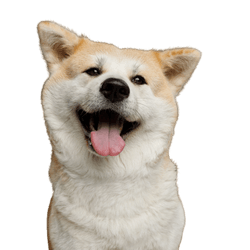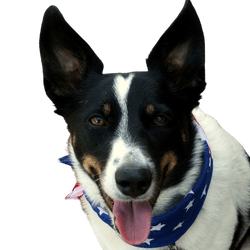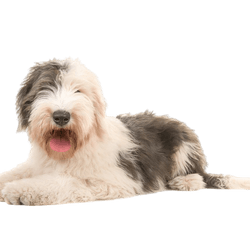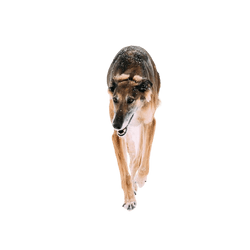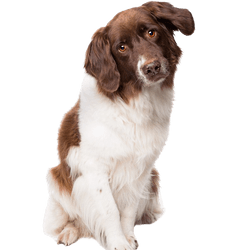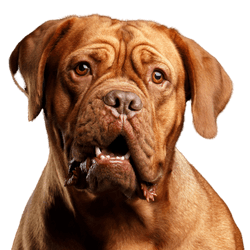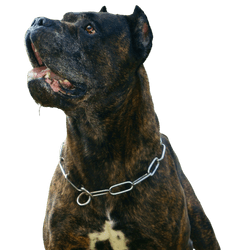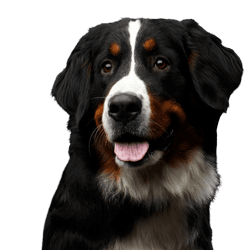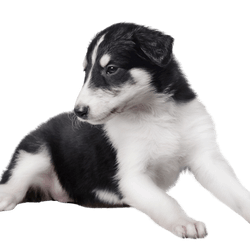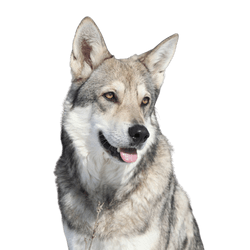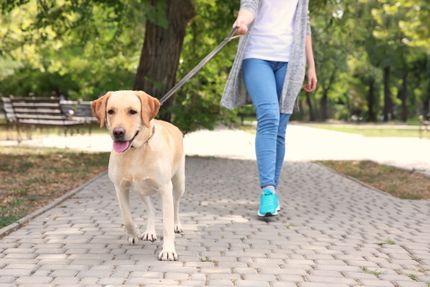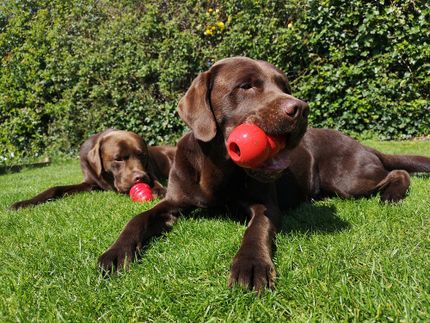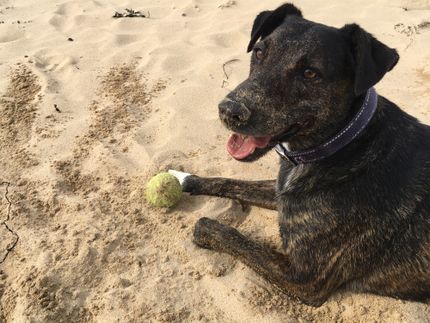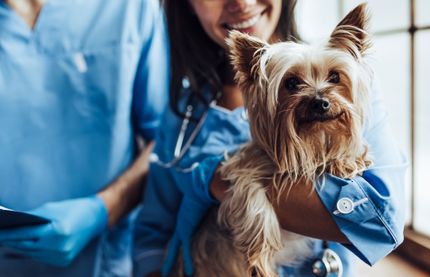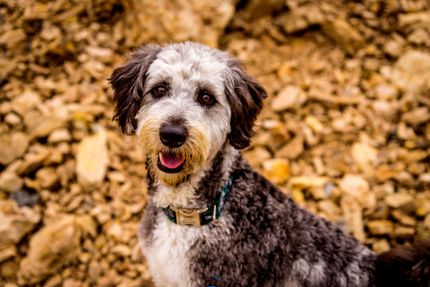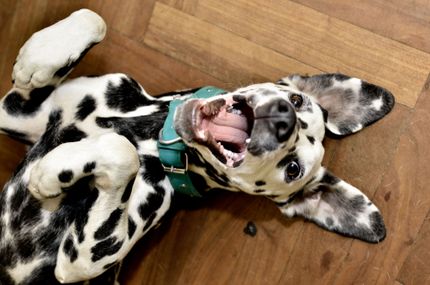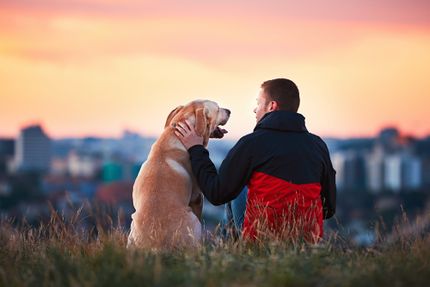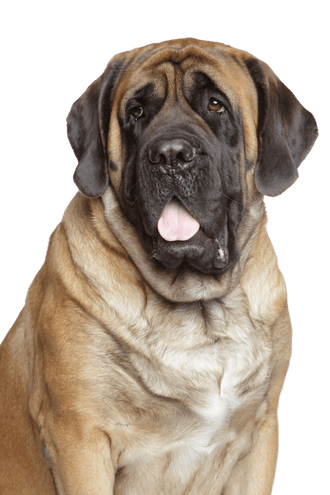
English Mastiff Breed description: Character & Co
English Mastiff
Facts & Origin
Introduction and etymology of the english Mastiff
Are you a dog lover with a preference for larger dogs and playing with the idea of buying an English Mastiff? Then you should first inform yourself about this dog breed and find out everything important about English Mastiff breeding.
The English Mastiff has the FCI standard number 264 and is therefore a recognised British dog breed. It belongs to group 2 "Pinscher and Schnauzer - Molossoid - Swiss Mountain and Cattle Dogs" and section 2.1 "Great Dane dogs". In addition, there are many other breeds which also include the name Mastiff, especially the Molosser. A synonym for the English Mastiff is also 'Old English Mastiff'. In science, the technical term Canis lupus familiaris is also used for the Mastiff.
In Germany, the Mastiff is listed as a dangerous dog breed in the federal states of Baden-Württemberg, Bavaria, Berlin, Brandenburg, Hamburg, Hesse and North Rhine-Westphalia. In Austria, this is also the case in Vienna and Vorarlberg. While in England it often takes the role of a guard dog, in Germany it is rarely represented.
The Mastiff or Old English Mastiff is an "original" in the dog world. Their ancestors fought at the side of proud commanders. Until today the Mastiff has remained in Great Britain as a watchdog and protection dog.
The name first appears as "Maystif" in the 14th century in the royal treatise "The Master of the Game and of Hawks" by Edmund of Langley, which he wrote for Henry IV. Etymologically, the meaning "Mast-teve" might come from the Low German description for "weighty, plump" or the Latin word "mixtivus" for "mixture". In 1991, Prof. Reul derived the English "mastiff" from the Latin "matinus" and translated it as "domestic, tame".
What is the origin of the English Mastiff?
The English Mastiff is considered the ancestor of various dog breeds that exist today, such as, to name just a few, the Great Dane or the Boxer. In the history of the Mastiff, which goes back to Roman times, the Mastiff has been described with the following four attributes in particular:
- from Britannia,
- a forehead covered with wrinkles,
- a broad mouth,
- a muscular physique.
The history of the Mastiff is as rich and varied as it is inaccurate and controversial. Originally, the Mastiff originates in Great Britain. However, the exact origin has not been agreed on, since there are several theories. Older theories refer to the Dogue de Tibet or Tibet Mastiff as the original ancestor, while others call it an original race that was formed indigenously and without human influence. The theory that the Mastiff is a mix of Tibetan and British dogs is not considered likely. Another theory says that the historical Mastiff is a descendant of the Molosser from Macedonia and Epirus, which arrived in England by boat.
As far as the historical function of this dog breed is concerned, they were particularly used as hunting and guard dogs and in war times. As Shaw put it: "A mastiff of true English blood loved battle more than its food. You could see its fame in its limping walk, scars from fighting for honour were on its face; a scratch on every limb, the frequent fights shortened its ears! (Shaw, 1891). The Mastiff was first documented as a dog in wartime use in 1415, when the battle of Azincourt raged. It is said that a massive dog protected its wounded master from attack.
Because of their special strength and robustness, Mastiffs have even been successful in the hunting of overpowering opponents such as bulls, bears or wild boars. A proof of a fight between one bear and six dogs dates back to the year 1050. Even in the Elizabethan Age, it was quite possible that Great Dane dogs competed against predators in arenas. Breeding in the modern understanding began around 1820.
If you like bigger dogs and do not shy away from dogs that are among the biggest and heaviest in the world, you can buy an English Mastiff if you meet all important criteria and in return will experience a deep bond of a very special kind. Or as William Shakespeare already expressed it in Henry V: "That island of England breeds very valiant creatures; their mastiffs are of unmatchable courage" (Act 3, Scene 7).
The FCI leads this dog breed under the standard no. 264, group 2, section 2: Molossoids and 2.1 Great Dane dogs. The Mastiff must not be confused with the Bullmastiff (cross between Mastiff and Old English Bulldog), which forms a separate breed.
The breed characteristics of the Mastiff
A muscular body and and a faithful look in their drooping eyes are their trademarks. To this day, these dogs have characteristic wrinkles on their face, head and chest. Fortunately, the efforts of the changing breeding standards are already taking effect and today you can see more "awake" and physically fit Mastiffs again.
The Mastiff is still considered a status symbol of the British upper class. Besides their new task as family dogs they serve as reliable guard dogs on many a noble estate.
- English "original"
- today more sportive breeding again
- typical drooping eyes, muscular body and big head
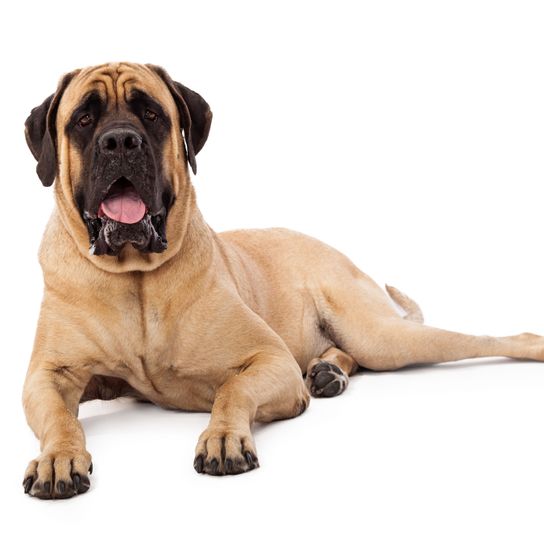
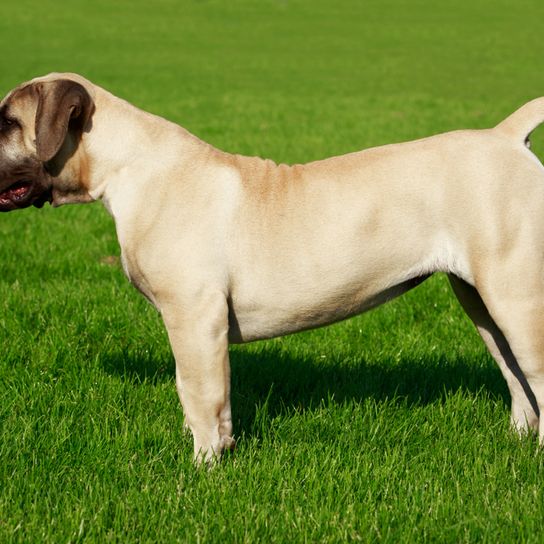
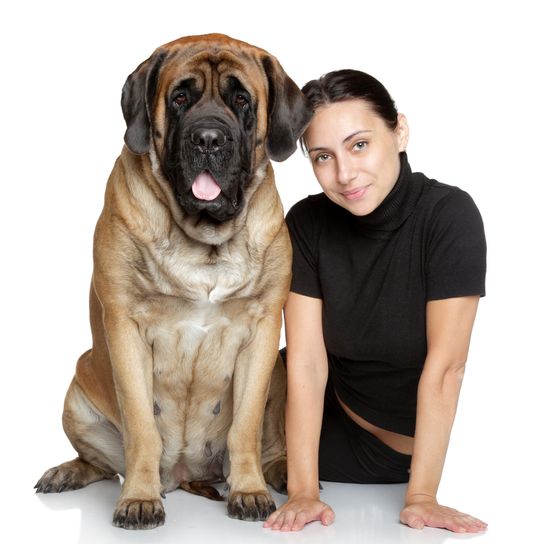
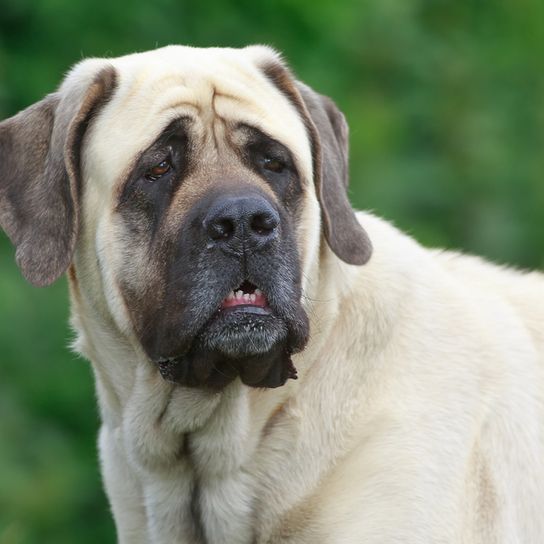
| Alternate Name | - |
| Origin | UK |
| Life expectancy | 6 - 12 years |
| Care requirements | low-maintenance |
| Activity level | average |
| FCI group | Molossian type |
| AKC group | working group |
| KC group | working group |
Attitude, character and temperament of the breed
A Mastiff is faithful until death! At least that's what the old heroic epics used to say. Fortunately, we live in relatively peaceful times today and so this dog can concentrate more on cuddling than on fighting.
They are affectionate and lovable creatures, if you know how to deal with them right. If you are afraid of the Mastiff, it will automatically become suspicious. You definitely won't be able to fight over leadership of the pack with this dog - they will win! It's better to keep it that way and raise your Mastiff like a normal dog from an early age. If you emphasise their mass, strength or uniqueness they will use it for their advantage later!
You should be able to offer this dog a house with ground level access and a large garden. They like to lie outside and act as a guard. If you get them used to regular exercise early on, they will gladly accompany you on leisurely walks.
Altogether, these dogs are considered to be very human friendly. The Mastiff only gained a bad reputation, because questionable owners wanted to make themselves important with them on their sides. Unfortunately, they landed on certain breeding lists because of these slips and their potential biting power.
What are typical characteristics of the English Mastiff?
The following characteristics are attributed to the English Mastiff:
- quiet
- harmonious
- loyal
- good-natured
- balanced/ calm
- restrained
- attentive
- peaceable/ very high stimulus threshold
- fixated on their "pack", their family
Their superficial appearance may give the impression of a dangerous and aggressive dog, but the exact opposite is the case!
Training
English Mastiffs need a consistent and gentle upbringing. They are suitable for experienced dog owners. They are less recommended for frist-time dog owners. Apart from a lot of attention and affection, the Mastiff needs to be provided with sufficient exercise above all. If you want to buy a Mastiff, it is best to own a large house with a garden. Small apartments without a garden are not suitable, because they are mainly outdoor dogs. In addition, they need a lot of free run. The Mastiff is very harmonious by nature, which is why it does not tolerate loud command sounds. Also, inconsistent behaviour confuses them. They need clear guidance. It is important to socialise this dog well, meaning that you should use their strength appropriately and assess it in such a way that they do not hurt anyone.
Character
Usage
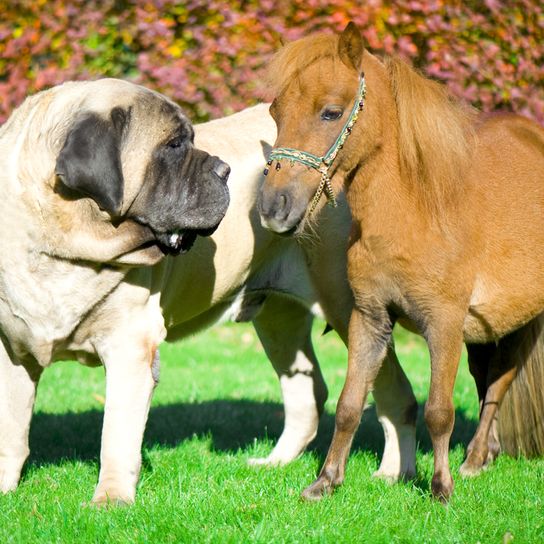
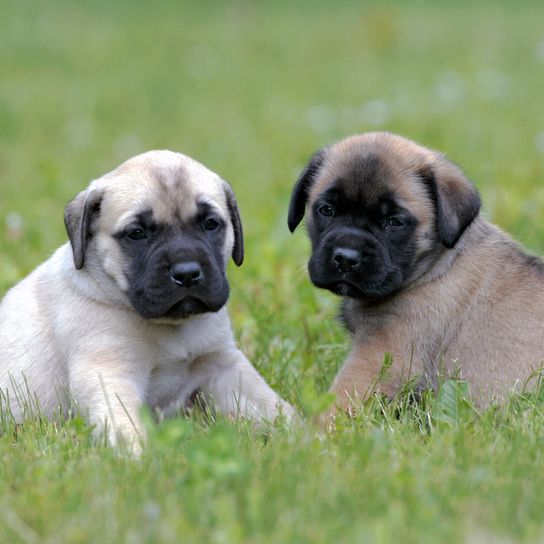

Health and breeding information
What are typical diseases of the English Mastiff?
The Mastiff has developed an increased susceptibility to diseases affecting the heart or eyes during the course of breeding. Their size and weight can also often lead to hip and elbow joint problems. Mastiffs are also prone to suffering from stomach torsion, which is why it is better to give them smaller portions of food several times a day. To this day, dogs of this breed are known to more commonly suffer from heart problems and skin problems due to their wrinkles. Both can be a legacy of overbreeding, depending on the breed.
What to consider when breeding English Mastiffs?
The FCI standards are decisive for breeding. It is important that all species-appropriate criteria are met, only then can a serious breeder be identified. Historically, pure breeding began around 1820 or 1835 in England. At that time there was disagreement about the appearance and colour. In 1872, the Mastiff Club was founded. St. Bernards when a smooth coat were crossed in. The Mastiff is also listed in the Club für Molosser e. V.
You can get a Mastiff puppy from a good breeder. However, these dogs are expensive. You have to expect to pay about 1500 Euro.
If you want to adopt a Mastiff, you might find a suitable specimen at "Molosser in Not".
In Germany, the Mastiff can be classified regionally as dangerous. You can get more detailed information about your place of residence from your local government.
Austrian dog owners need a special permit in the federal states of Vienna and Vorarlberg in order to be allowed to keep a Mastiff.
The Swiss cantons of Geneva and Valais have completely banned the keeping, breeding and import of the breed. In Freiburg, Schaffhausen, Thurgau and Ticino you need a special permit to keep the breed.


What are the (external) breed characteristics of the English Mastiff?
According to FCI the typical breed characteristics are stated as muscular and large. The right proportion of size and weight makes them a well-proportioned specimen. While the rib cage is characterised by width and depth, their body stands out with their impressive muscles. Also, the broad skull shape between the drooping ears as well as the wrinkled forehead are typical features of this breed. Their chaps hang down slightly. In addition, ears and nose should be dark in colour. The coat is short and should not be too fine. The following colours are permitted: apricot, sand-coloured and brindle. The tail is spindle shaped, thinly coated and is carried rather low.
How big does the English Mastiff get and how much does it weigh?
Males have a withers height of 80 cm and above, bitches can reach 70 cm or taller. The ideal weight is about 90 kg, whereas 90 kg should be the maximum weight, which makes the Mastiff a particularly heavy dog. The male Aicama Zorba La-Susa even entered the Guinness Book of Records in 1989 with a weight of about 155 kg, which made him the heaviest dog in the world. According to FCI it is important that the size and the weight of the Mastiff are in an appropriate relation to each other.
The coat is short and dense. The Old English Mastiff can be sand-coloured, brindle, grey or brown.
- large to massive dog
- Body should be strong but not overweight
- short and easily groomed coat
- sand-coloured, brindle, grey or brown
- faithful and loving look
What is the average age of an English Mastiff?
The average life expectancy is about 6 to 12 years. Larger dogs have a shorter life expectancy than small dogs. Nevertheless, the English Mastiff can reach a reasonable age with proper care.
| Fur length | short |
| Fur | flat coated |
| Ear shape | Floppy Ear |
| Tail | lang |
| Anatomy | hefty |
| Size ♀ | 70 - 91 cm |
| Weight ♀ | 73 - 100 kg |
| Size ♂ | 70 - 91 cm |
| Weight ♂ | 54 - 77 kg |
| Suitable For | - |
Colors
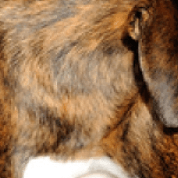





Known Diseases
Eye diseases
Often occur with allergies and intolerances.
Elbow dysplasia (ED)
Elbow joint dysplasia is a chronic disease complex of the elbow joint of fast growing dog breeds.
Skin inflammations
Can be hereditary in certain breeds.
Heart disease
Can occur frequently in dogs and can sometimes be treated with medication.
Hip dysplasia (HD)
The hip dysplasia or hip joint dysplasia of the dog (HD) is a maldevelopment of the hip joint.
Damage to the gait
Often seen in severely overweight dogs and heavy breeds.
FAQ
-
Yes, the Mastiff is on the list of dangerous dog breeds in Germany, Austria and Switzerland.
-
A Mastiff is quite expensive and can cost up to 2000 Euros.
Other large dogs
Useful Articles
You can find articles that might interest you in the dogbible blog to match your favorite breed.
Visit our magazineto stay up to date on dog trends.
To find out more, view our Privacy Policy
Find here the breed that suits you and find out what character traits it has. Here you can also learn more about the origin, size and weight of your favorite breeds.
Matching your favorite breed, you'll find articles that might interest you on the dogbible dog blog.
Shortening the claws of a dog - this is what you have to pay attention to
First vaccinations for the puppy - Legal situation, What vaccinations are good and important
Winter hiking with your dog - these 5 tips will help you work as a team
